
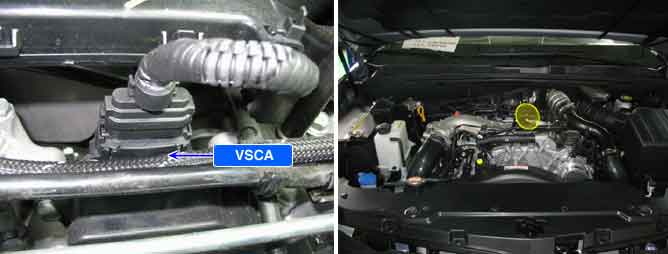
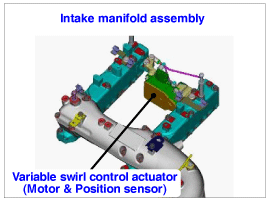
VSCA (Variable Swirl Control Actuator) consists of DC motor - which is installed on the one out of two intake port connected to each cylinder, controlled by ECM, Motor position sensor (potentiometer) which senses real rotation angle of adjustment shaft then, sends this signal to ECM, and finally mechanical return system (return spring) for idle position.
ECM optimizes air circulation intaking to combustion chamber corresponding to engine condition. Low intaking speed range such as idle or engine speed is below 3000rpm will get swirl valve closed to increase swirl effect that increases fuel/air mixture and reduces NOx and PM approx. 10 ~ 15% with lots amount of EGR.
The range that engine rpm is over 3000rpm can not get swirl effect. Therefore, swirl valve has to be opened to improve intaking efficiency and power decrease by pumping loss.
Furthermore, ECM prevents swirl valve and shaft from stucking foreign materials and controls swirl valve open and close to maximum position twice right after Engine in order to learn maximum open and close position under the condition that the coolant temperature is over 70℃.
In case of replacing VSCA , perform the "COMPONENT CHANGE ROUTINE" procedure with scan tool. If the "COMPONENT CHANGE ROUTINE" procedure has not completed until automatic learning completed, it may cause vehicle performance and exhaust gas problem.

【Swirl valve operation】ECM controls that actuator operates lever to get the swirl valve adjustment shaft to required position. Operating angle of swirl is 90°.
1. Valve open (clockwise, 5%→95%) : ECM generates 13.2V PWM signal to get target value→DC Motor operation→Shaft rotation→ Valve open.( high speed and high load range)
2. Valve close (count clockwise, 95%→5%) : ECM generates 13.2V PWM signal to get target value→DC Motor operation→Shaft rotation→Valve open.(idle and mid speed and load range)
P2015 is set if variable swirl valve position fails to reach target position within 2.5 sec. while ECM already outputted motor driving signal (swirl valve fully open or close signal). This code is due to 1) swirl valve shaft stuck or problem of link device or 2) variable swirl valve position sensor output value stuck.
If motor (+) or (-) is completely open, DTC P2009 (Open) and P2015 (Stuck) are retrieved together. But, in case of intermittent open, DTC P2015 (stuck) is first. In this condition, if the circuit which is intermittent open is back to normal condition before power off, DTC P2009 (Open) is not retrieved.
Item | Detecting Condition | Possible Cause | ||
DTC Strategy |
•
Voltage monitoring |
•
Variable swirl valve shaft stuck
•
Variable swirl valve link device problem
•
Variable swirl valve position sensor component | ||
Enable Conditions |
•
IG key ON or engine running | |||
Threshold Value |
•
Variable swirl valve operating motor mechanically stuck. | |||
Diagnostic Time |
•
2.5 sec. | |||
Fail Safe | Fuel Cut | NO |
•
Swirl valve opened at variable swirl control actuator failure. | |
EGR Off | NO | |||
Fuel Limit | NO | |||
Check Lamp | OFF | |||
DC motor resistance | Position sensor resistance | Position sensor output voltage |
3.43 Ω ~ 4.37 Ω (20℃) | 3.01 kΩ ~ 5.59 kΩ (20℃) | 0.17 V ~ 4.83 V |
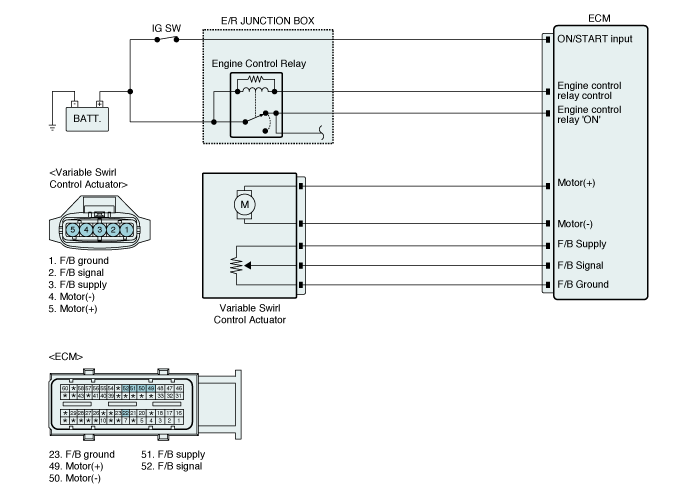
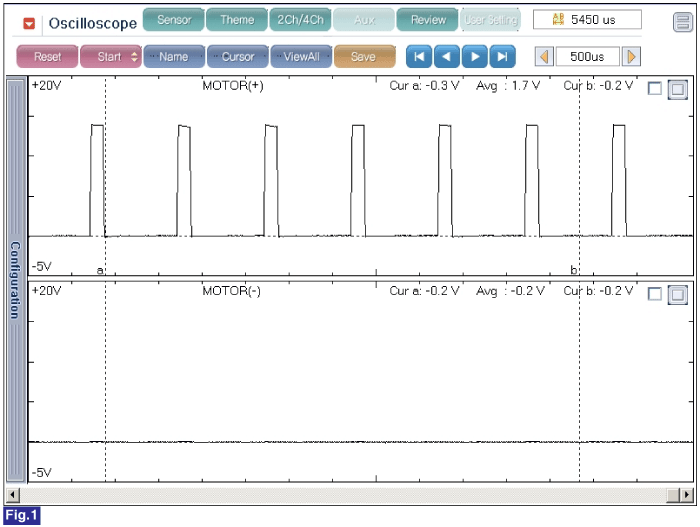
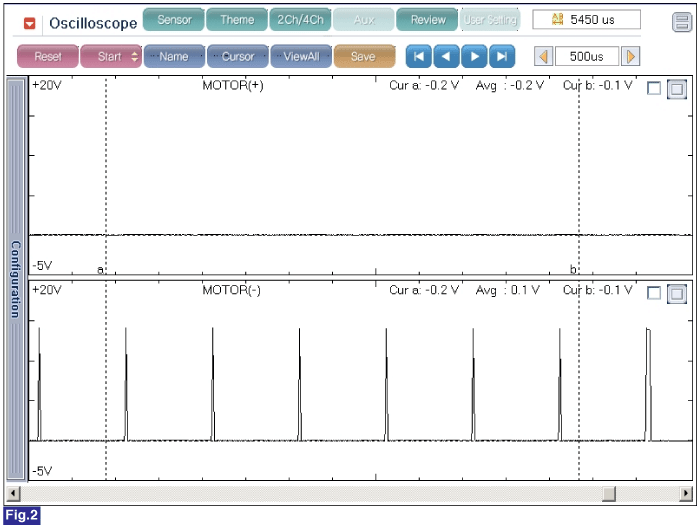
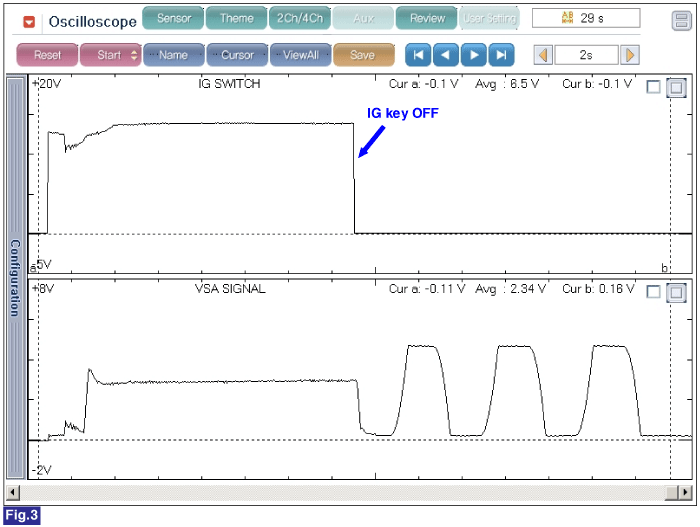
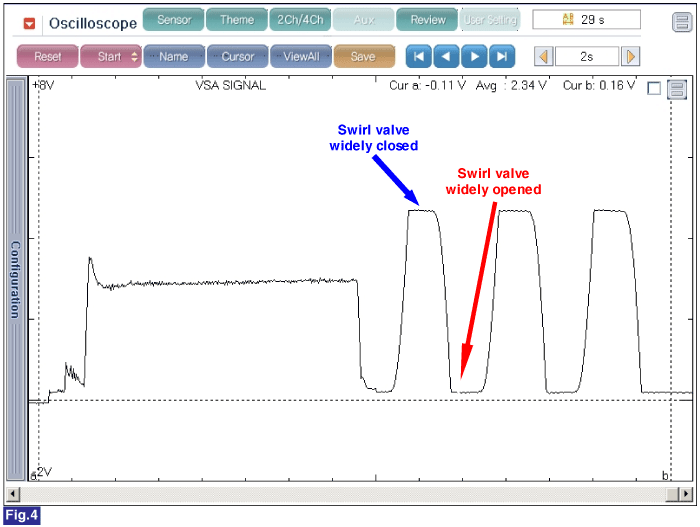
Fig.1) Signal waveform when variable swirl valve closed at idle.
Fig.2) Signal waveform when variable swirl valve opened at acceleration.
Fig.3) Signal waveform of variable swirl control actuator motor position sensor at the point of turning engine OFF.
Swirl valve is opened and closed three-time at engine OFF.
☞ ECM controls swirl valve to wide open and wide close position in order to learn swirl valve position at IG key OFF under the condition that engine coolant is over 70℃.
Fig.4) Swirl valve is opened and closed three-time at engine OFF.